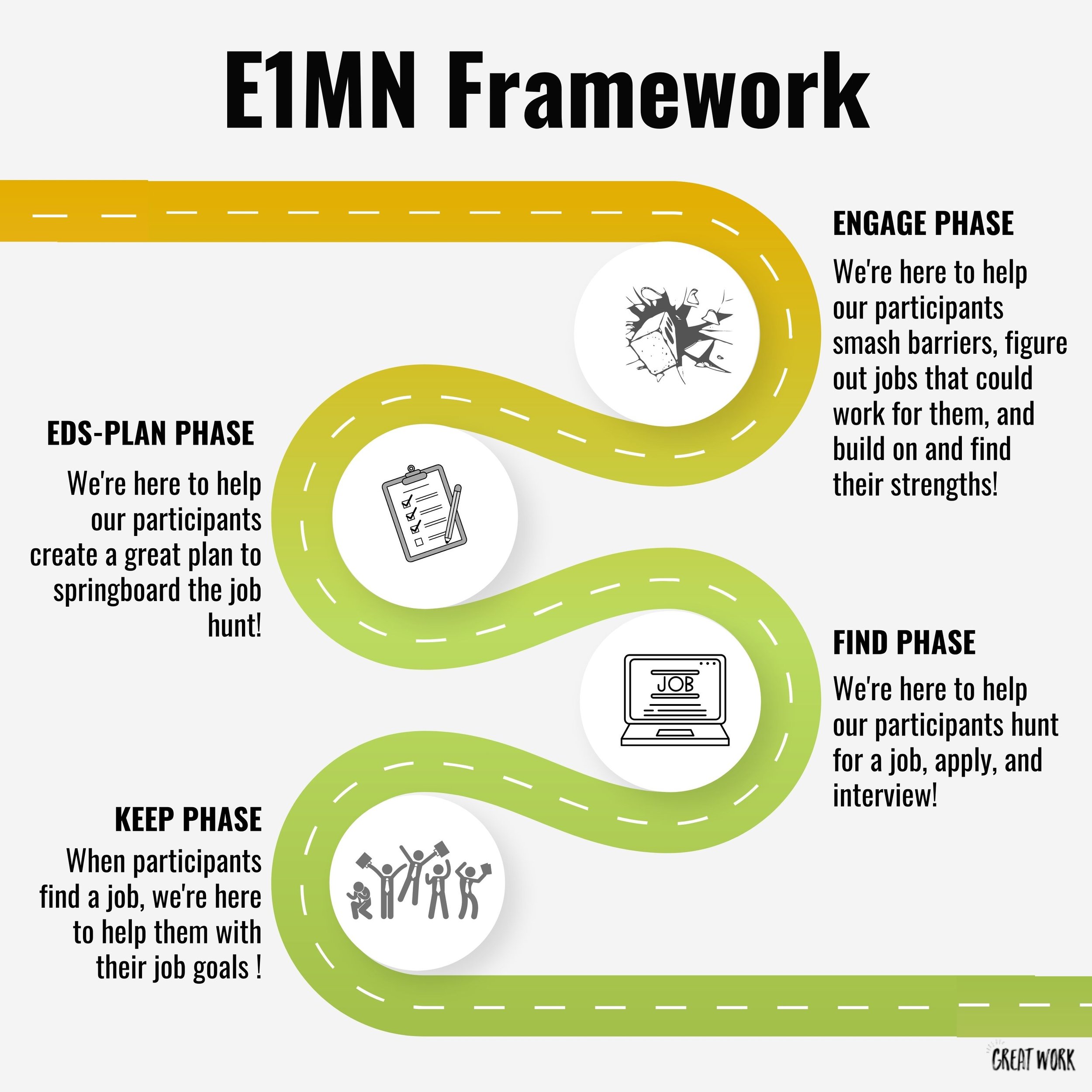
Keep Phase Services
Keep Phase Overview
Employment Support Services (ESS)
The Keep Phase service’s goal is to build on workplace strengths, build independence at the job site, and help participants communicate with and advocate to employers. This is an awesome time to build strong relationships with employers!
The Keep Phase should result in maintaining and succeeding in employment. We always want to find ways to enable our individuals to be as independent as possible with the services we provide.
Our support could look like heavier on-the-job support that is responsibly faded to biweekly check-ins depending on needs.
This phase is funded by Medicaid waivers (DHS)! The specific service is Waiver Employment Support Services (ESS). You will see Waiver Employment Development Services (planning phase) on documentation like 6790s & referral forms.
Ask your participant how they would like you to introduce yourself at the worksite.
The best practice is to schedule worksite visits at a set time and then send reminder texts.
“I have a new job! My employment case manager is helpful when I have questions, or if I have trouble learning something new, or when I want help talking with my boss.”
Important Deadline: Keep Phase Documents need to be updated annually. A Support Assessment should be completed monthly.
Keep Phase Services
-

Ongoing Support
-

Employer Support
-

Breaking larger responsibilities into smaller tasks and creating assistive tools, visual aids, and checklists
-

Training on job responsibilities, appropriate workplace behavior, and/or professional workplace relationships
-

Researching available transportation options and providing transportation training
-

Coaching to understand wages and benefits
-

Guidance and support navigating the “interactive process” with employer to request workplace accommodations
-

Onboarding Support
We offer assistance in onboarding at organizations. We don’t need to be an expert in I-9s, W4s, or other documents.
Often times our participants like our support while onboarding or during their first shift.
-

No Job Hunting!
Keep Phase Phase FAQs
-
Keep Phase: Keep Phase email updates should include how is their job going and any concerns that came up. If there are areas of improvement needed, using the sandwich method (positive thing, one challenge, positive thing) can be a great way to introduce those concerns!
Every week by Friday, Great Work team members send a weekly email update to your client’s team giving them an update about how the week has been going, the progress that was made, and any concerns that you have. These should be informative, pertain to your client’s employment journey, and paint a picture of the progress for the week (even if there hasn’t been any). These should always be person-centered and maintain their dignity, even when sharing concerns.
A lot can happen in a week, but emails are more likely to be skipped over if they’re long. Try to fit it into two or three short paragraphs!
Your email updates should include any important people on that person’s team, including case manager, guardian, or any other service providers. Make sure you talk with the individual about whom they would like to be included in the email update!
We should be making meaningful progress each week. However, if you haven’t made any progress for the week, you should highlight why you weren’t able to make progress and what you plan to do next week to continue to make progress!
Engage Phase: Engage Phase activities you’ve arranged or completed, current progress towards completing the Engage Phase, and any barriers that you have encountered that have slowed the process down.
Plan Phase: Plan Phase activities you’ve arranged or completed, current progress towards completing EDS-Plan checklist, and any barriers that you have encountered that have slowed the process down.
Keep Phase: Keep Phase email updates should include how is their job going and any concerns that came up. If there are areas of improvement needed, using the sandwich method (positive thing, one challenge, positive thing) can be a great way to introduce those concerns!
-
Check-in to see how your client is doing at their job!
Complete Needs Assessments (with client permission)
Ask how work is going
Ask if there are any concerns or if they would like your assistance with anything
Work on a specific employment-related task or improvement that you noticed your client could use some help in!
This is a great time to establish stronger relationships with client supervisors. You're there to help them as well!
Don’t distract a participant while they’re working to do a check-in. You can connect with them on a break or outside of work.
-
Connect with your participants supervisor at least once every two months.
Ask:
What are they doing well?
What do they need to improve on?
If there are any new skills they can develop or opportunities
We want our clients to build independence in their workplace; which means that it is important that their supervisor can also feel confident turning to the client with their concerns.
We should be encouraging the managers to talk with the clients directly about the concerns that they have. We can help support the manager in talking with the client directly by setting up a time for the manager, the client, and yourself to meet to talk about their concerns and create a plan to fix it.
Please keep in mind that some managers will state that things are going well, even when they have a lot of concerns! Ask very specific questions and frame questions in a positive way, where the manager feels comfortable talking about their concerns.
-
It’s a great goal to be completing two Needs Assessments per participant per month.
-
Ask your client “Why?” questions to see if you can deduce the reason why they were terminated or quit.
If they would like to try to get their job back, facilitate a conversation between the employer and your client.
Depending on their situation, see what service they would like you to provide for them. Engage: If they are not sure if they even want a job in the community anymore and would like to go back to the drawing board. Follow the Amending the 6790 section below.
EDS-Plan: If they know they would like to work in the community but would like some more job exploration options (business tours, informational interviews, job shadows, or job tryouts) or some pieces of the Plan may need to be updated. This is great if your client may want to explore a different industry or job type. Follow the Amending the 6790 section below.
Find: If your client has the same clear and realistic job goal and would like a job as soon as possible! They may already still be enrolled in VR services.
Keep: You can continue providing Keep Phase services if your client quit their job and got a new one. Make sure you let their case manager know and to update it in REV.
Reach out to the employer or any other key players in the client’s employment journey to see if you can get their side of the story or any feedback that can help your client in their next job hunt. It’s super important to leave workplaces on good terms!
Reach out to the case manager and/or VR counselor and let them know.
Send an amended 6790 once your client has made an educated choice about what service they would like you to provide to their case manager. If they would like you to continue job hunting through VRS, then either reenroll them in VRS or connect with their current VR counselor.
-
There may or may not be an intake meeting for this phase.
If your client is moving from another waiver service, you do not need an intake.
If your client is new to Great Work, you would need an intake!
-
Important note: if an employer is busy, connect with them at a different time. We don’t want to be an inconvenience!
Go up to the employer and give them your business card. Let them know that you’re assisting your participant achieve their employment goals and that you’re excited to meet them.
-
If a participant wants to try to be crossed trained or take on additional responsibilities, we can ask if they’d like Great Work to assist them in communicating that with their employers or HR. That may allow for them to be scheduled for more hours.
What if the supervisor or HR says not right now?
Ask if there are any job duties or parts of their day that they don’t like doing... maybe a manager doesn’t like opening the store on the weekend.
Ask for any feedback or ways your participant can show initiative! They may need some room to grow to take on some duties, so it’s important to try to hammer those out and work on them. Employers love to see employees wanting to grow.
Your participant could let their employers know how much they love their job and wants to stick around. They’d be a great investment to train in additional duties – no matter how small they may be.
-
Use positive redirection to redirect your participant to the task at hand.
If you notice that you may be a distraction, create some space between the two of you.
-
You should have a conversation with your participant to make sure that they are educated and informed that her actions at their job have consequences. It is their choice to not to work or listen, but it is also their place of employment's choice to not put them on the schedule or terminate as a result.
-
Ask the employers what the participant would need to improve on.
ECMs should be offering to come into the worksite to observe and complete an assessment of their performance and needs (Needs Assessments). This should be tailored to what we’re trying to assess based on what the employer shares with you about their concerns.
Offer training outside of work in check-ins to practice problem areas or duties.
Let’s say you goes to the job site, completes some Needs Assessments, and find that your particpant does everything perfectly... then we have some great documents and proof that the participant is competent in her job duties. This could lay out a foundation of proof in case the employer is being discriminatory and then we can advocate accordingly.
Employment Support Assessment Benefits
The documentation can help support independence in the case of employers or guardians requesting a job coach.
The documentation provides proof of great work in case the participant wants additional job duties raises, or promotions.
This support assessment gives other ECMs great documentation to collaborate or brainstorm off of.
This support assessment gives your participant a chance to reflect on their workday and how they work.
Required 245D Meetings
Participants receiving Engage Phase services are funded by Waiver Services.
By 245D Statues, Great Work is required to lead Intake Meetings,45-Day Meetings, and Annual Meetings for all Waiver participants.
The purpose of an Intake Meeting is to go over Great Work’s Intake Paperwork as well as for the GW staff member to discuss how they can best support their client.
The purpose of a 45-Day Meeting is to check the progress made during the first 45 Days and make any adjustments needed.
The purpose of an Annual Meeting is to go over documentation and to ensure Great Work’s services best fit our client’s needs.
6790 Overview
The 6790 is the tool providers use to supply case managers with the information they need to complete authorizations for their clients to receive services from Great Work. The 6790 should reflect the current E1MN phase that the client is in and the number of units (or 15-minute increments) that we anticipate that we will use during a given time-frame.
6790s are only required for Waiver services. Employment Exploration Services (EES), which you provide in the Engage Phase, is a Waiver service. That means you need a 6790!
The E1MN Framework
The Employment First Minnesota Framework (E1MN) is designed to help make sure that Great Work helps our participants explore employment, plan for employment, find a job, and keep a job that is a perfect fit for them! Click below to learn more about each phase:





